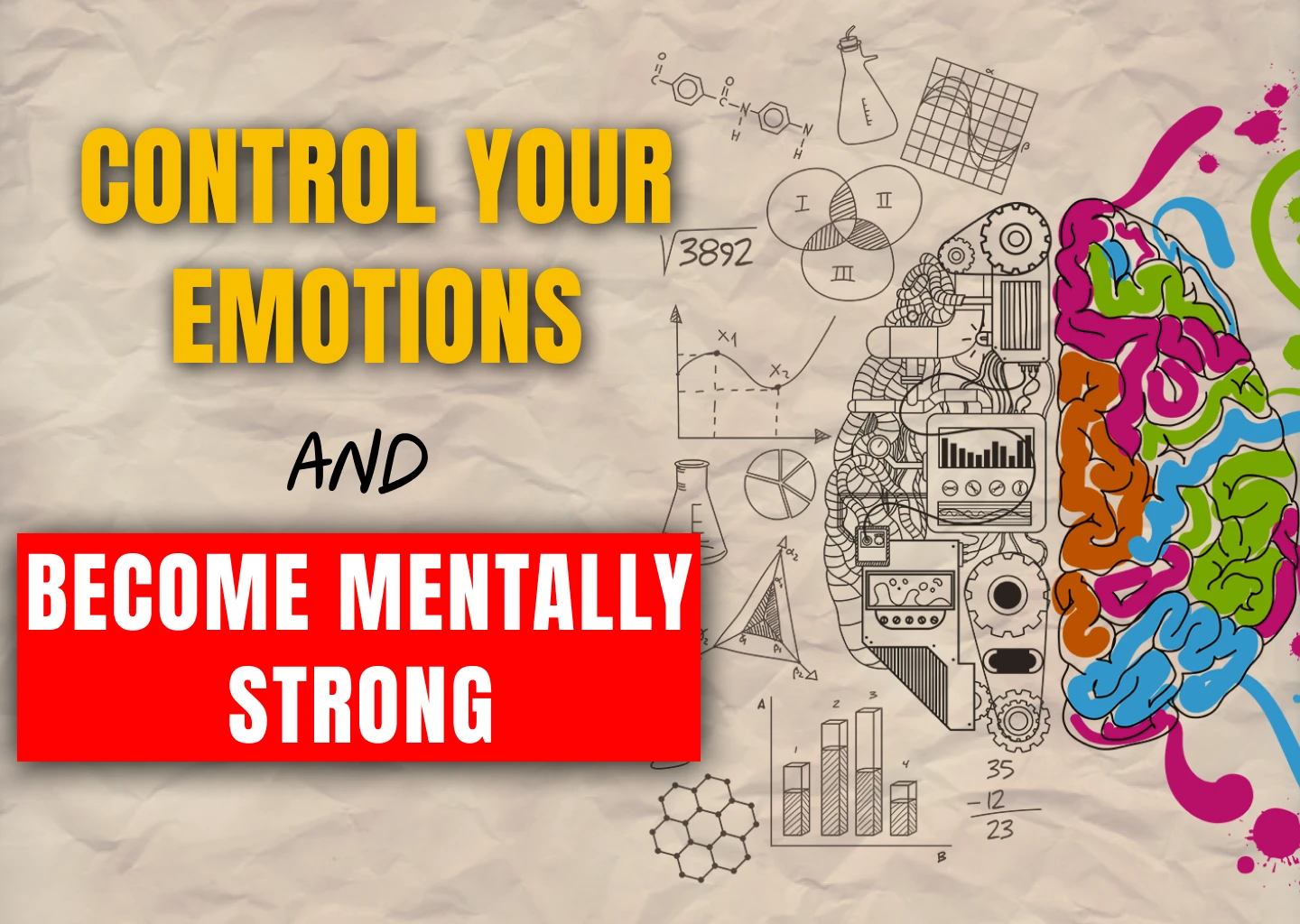Top 10 Techniques To Control Your Emotions And Become Mentally Strong

1 year ago

Introduction
- Hook: Start with a relatable anecdote or a quote about the importance of emotional control and mental resilience.
- Importance of Emotional Control and Mental Strength: Briefly explain why these traits are essential for personal growth, success, and well-being.
- Purpose of the Article: State the goal of the article—to provide effective techniques for controlling emotions and building mental strength, along with the unique benefits of each.
Techniques for Controlling Emotions and Building Mental Strength

Let’s dive into some simple, practical techniques to help you get a better grip on your emotions and strengthen your mental resilience. Each technique offers unique benefits and can be gradually integrated into your life. Ready to get started?
Technique 1: Practice Mindfulness and Meditation

Mindfulness and meditation have become go-to practices for a reason! These techniques are all about focusing on the present moment and becoming aware of your thoughts without judgment. Picture this: instead of reacting instantly to a stressful situation, you take a deep breath, observe your feelings, and respond calmly.
How to get started: You don’t have to sit cross-legged for hours to feel the benefits. Just take a few minutes each day to breathe deeply or listen to a guided meditation. The goal is to slow down, notice what’s going on inside, and embrace a little calm.
Benefits: When you make mindfulness a habit, you’ll find it easier to keep your cool in tense situations, gain a clearer mind, and feel less reactive overall.
Technique 2: Reframe Negative Thoughts
Ever catch yourself spiraling into negative thoughts? You’re not alone, and here’s the good news—you can train your mind to shift these thoughts into more constructive ones. It’s like turning down the volume on that inner critic and turning up the voice that cheers you on.
How to get started: Next time a negative thought pops up, ask yourself, “Is this helping me?” If not, see if you can reframe it. For instance, “I’ll never get this right” can become, “I’m learning, and I’ll improve with practice.”
Benefits: This small shift can make a big difference! Reframing encourages optimism, helps you think more clearly, and keeps you solution-focused, even on tough days.
Technique 3: Build Self-Awareness

Understanding yourself is key to staying in control. Self-awareness means getting curious about what triggers your emotions and recognizing your typical responses. The more you know about yourself, the easier it is to handle emotional ups and downs.
How to get started: Try keeping a journal or taking a few minutes each day to reflect on what triggered certain emotions. Even chatting with close friends or family can offer insights into how you react and why.
Benefits: Becoming self-aware helps you make better decisions, navigate tricky situations with confidence, and strengthen relationships by understanding your own and others’ emotional needs.
Technique 4: Set Healthy Boundaries
Healthy boundaries are like invisible shields that protect your energy and mental well-being. They help you say “no” when you need to and create space for what truly matters to you.
How to get started: Think about where you feel drained or overextended. Maybe it’s saying yes to too many social commitments or letting work spill into personal time. Set small, clear limits, like reserving evenings for yourself or scheduling “you” time.
Benefits: Boundaries reduce stress, prevent burnout, and show that you value your own needs. They help you protect your time and energy, which is a big step toward mental strength.
Technique 5: Practice Emotional Detachment
Emotional detachment doesn’t mean being unfeeling; it just means learning to let go of outcomes you can’t control. When you focus on what you can influence, you stop getting tangled up in stress about things beyond your reach.
How to get started: Start by listing situations that you can’t control, like someone else’s reaction or unexpected changes. Then, whenever you feel stress building, remind yourself to focus on your actions rather than the outcome.
Benefits: By practicing detachment, you’ll feel less anxious, more at peace, and able to concentrate on things that truly matter to you.
Technique 6: Exercise Regularly

You probably already know that exercise is great for your physical health, but it’s also a powerful tool for your mind. Physical activity releases endorphins, which are like little mood boosters that help you manage stress.
How to get started: Don’t worry if you’re not a gym person! A brisk walk, a bit of yoga, or even dancing around the living room can lift your spirits. The key is consistency, not intensity.
Benefits: Regular movement can reduce anxiety, improve your mood, and make you more resilient. Plus, it’s a great way to take a break and reset!
Technique 7: Challenge Yourself Gradually
If you’ve ever faced a challenge and come out stronger, you already know the value of stepping outside your comfort zone. By taking on small challenges regularly, you’re training yourself to be more resilient.
How to get started: Set small, manageable goals that push you just a bit beyond your comfort zone. This might be trying a new skill, speaking up in a meeting, or even tackling a fear—one step at a time.
Benefits: Gradual challenges build confidence and prepare you for bigger obstacles. With each small victory, you’ll feel more capable and ready to take on whatever life throws at you.
Technique 8: Practice Gratitude Daily
It sounds simple, but practicing gratitude can be life-changing. Shifting your focus to what you have rather than what you lack can uplift your mood and make emotional challenges seem more manageable.
How to get started: Each day, write down three things you’re grateful for. They can be big or small—anything from a loved one’s support to a good cup of coffee.
Benefits: Gratitude promotes a positive outlook, enhances resilience, and deepens your appreciation for life. It’s an easy way to keep yourself grounded and joyful.
Technique 9: Learn to Let Go of Perfectionism
Perfectionism might seem like a strength, but it often becomes a source of stress and self-doubt. Embracing imperfection means giving yourself the grace to learn and grow without constant pressure.
How to get started: Instead of striving for perfection, aim for “good enough.” Celebrate small successes and view mistakes as opportunities to learn. Remember, progress is better than perfection!
Benefits: Letting go of perfectionism relieves stress, helps you be kinder to yourself, and makes you more adaptable. It also encourages a growth mindset, where you focus on improvement, not flawlessness.
Technique 10: Surround Yourself with Positive Influences
You become like the people you spend the most time with, so choose wisely! Surrounding yourself with positive, encouraging people can boost your own emotional and mental well-being.
How to get started: Spend more time with people who uplift you, inspire you, and challenge you in a supportive way. If there are negative influences in your life, consider limiting contact.
Benefits: Positive influences help keep you motivated, provide support when you’re feeling low, and reinforce positive habits. They remind you of your potential and keep you focused on growth.
Each of these techniques offers a unique way to enhance your emotional control and mental strength. Try incorporating one or two into your routine, and over time, you’ll start to feel the benefits!
Integrating the Techniques into Daily Life
Now that you’ve got a set of tools to build your emotional control and mental strength, let’s talk about how to make these techniques a natural part of your day-to-day life. Taking action, even in small steps, can make a huge difference over time. Here’s how you can bring these techniques into your routine in a way that feels manageable and meaningful.
1. Creating a Routine
Consistency is key to building new habits, so let’s look at ways to make these techniques part of your everyday life without overwhelming yourself. The good news? You don’t need hours each day to see the benefits! A few minutes here and there can go a long way.
- Start Small: Pick one or two techniques that resonate with you and try them consistently for a week. For instance, if mindfulness and gratitude speak to you, set aside five minutes in the morning for a breathing exercise and jot down a couple of things you’re grateful for at night. By starting small, you won’t feel pressured to keep up with a long list.
- Find What Works for You: Some techniques will naturally fit better into your life than others. If you’re a night owl, practicing mindfulness before bed might feel more relaxing than doing it first thing in the morning. Or, if exercise is something you struggle with, find a fun way to make it happen, like joining a dance class or taking evening walks.
- Make It Enjoyable: When you enjoy something, you’re more likely to stick with it. So don’t force yourself to meditate if it feels unnatural; try a gratitude practice or journaling instead. The goal is to feel uplifted and motivated by these techniques, not burdened.
2. Tracking Your Progress
It’s easy to underestimate your progress, especially with practices that work gradually over time. That’s why tracking can be a game-changer—it helps you see the little wins that add up.
- Keep a Journal: Write down your thoughts, reactions, and experiences with each technique. If you’ve been working on reframing negative thoughts, note any times you caught yourself thinking differently or feeling more optimistic. For emotional detachment, reflect on a situation where you let go of control and how it felt.
- Celebrate the Small Wins: Give yourself credit for small steps. Every time you manage to exercise or take a moment to reflect on your day, acknowledge it! Celebrating these wins keeps you motivated and helps you see that these practices are becoming a part of who you are.
- Check in with Yourself: Set a reminder to check in with your progress every couple of weeks. How do you feel compared to when you started? Have you noticed any changes in how you react to stress? Regular check-ins help you stay accountable and give you the chance to adjust your approach if needed.
3. Adapting Techniques as Needed
Life changes, and so do your needs and priorities. Maybe mindfulness was helping you during a stressful project, but now you feel that setting boundaries needs more attention. Don’t feel tied to any one approach—these techniques are here to serve you, not the other way around!
- Listen to Your Intuition: Pay attention to what feels right. Some days you might need a little extra self-awareness, while other days a gratitude practice might be all you need to boost your mood. Trust yourself to know what’s most helpful at any given time.
- Switch It Up: If you feel yourself getting into a rut, switch things up a bit. For example, if you usually do the same gratitude exercise, try a new form, like writing a letter of appreciation to someone or listing things you’re thankful for in nature. Keeping your practice fresh prevents boredom and keeps you engaged.
- Adapt to Your Schedule: Life gets busy, and it’s easy to let self-care fall to the wayside. If you’re strapped for time, see if you can incorporate these practices into things you already do. Practice mindfulness while doing the dishes, take a few deep breaths in traffic, or go for a walk on your lunch break.
4. Embracing the Journey
Building emotional control and mental strength isn’t a quick fix; it’s a journey. There will be days when you feel on top of things and days when you feel like you’re back to square one—and that’s completely normal.
- Be Patient with Yourself: Growth takes time. If you miss a day or slip up, don’t be hard on yourself. Just get back on track when you’re ready. Remember, this is a lifelong journey and every little effort counts.
- Trust the Process: It might take weeks or even months before you notice a big shift. Some benefits, like greater resilience or more calm under pressure, build slowly. But trust that with consistency, you’ll get there.
- Celebrate How Far You’ve Come: Reflect on any progress you’ve made, no matter how small. Notice if you’re reacting more calmly in tough situations or feeling more grateful regularly. These are signs that you’re building strength and resilience.
5. Finding Support Along the Way
You don’t have to do this alone. Surrounding yourself with positive influences or even finding a like-minded community can make a big difference.
- Share Your Journey with Friends or Family: If you have supportive people in your life, let them know about your goals. They can encourage you and might even join you in some of the practices, like exercising or practicing gratitude.
- Look for Communities: Many people are working toward mental and emotional growth, so why not join them? Look for online groups, forums, or local meet-ups focused on mindfulness, self-improvement, or emotional resilience. Being part of a group can help you stay motivated and learn new strategies.
Conclusion
- Summary of Techniques and Their Benefits: Briefly recap the ten techniques and highlight their unique benefits.
- Final Encouragement: Reassure readers that emotional control and mental resilience are skills that take time and practice but can be developed.
- Call to Action: Invite readers to start implementing these techniques today to begin their journey towards greater emotional control and mental strength.